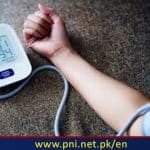ISLAMABAD, OCT 26 (ONLINE): Thousands of people in the United States experience a stroke each year. Strokes can lead to death and long-term disability.
The American Heart Association and American Stroke Association have just released updated guidelines for primary stroke prevention.
The guidelines highlight sex-specific screening and prevention updates, as well as healthy lifestyle recommendations.
People can work with their doctors to take steps towards healthy lifestyles that decrease the chances of strokes.
Stroke prevention is a critical interest of health promotion. In the United States, over 795,000Trusted Source strokes occur each year.
Doctors are interested in helping people prevent strokes whenever possible, and to do so they must use accurate guidelines and research updates.
The American Heart Association (AHA)Trusted Source and American Stroke Association (ASA)Trusted Source assist with research and data guidelines. The groups recently published the “2024 Guideline for the Primary Prevention of Stroke” in the journal StrokeTrusted Source.
The paper updates the 2014 guideline and aims to support the efforts of doctors and health groups in stroke prevention.
What do the new stroke prevention guidelines say?
These new guidelines seek to add information and make appropriate changes based on new data. To write the new guidelines, researchers conducted a review of the literature published after 2014 in several databases. The authors also reviewed previous documents from the AHA and ASA regarding stroke prevention.
The guidelines also discuss social determinants of health that can impact people’s risk for stroke, but note that they focus primarily on individual changes rather than systemic interventions.
The authors further recommend screening for factors like healthy food access, health insurance, and neighborhood safety, as this may help identify barriers to stroke prevention efforts.
Migraine, endometriosis emerging risk factors for stroke
In terms of assessment, they recommend screening adults for stroke-related risk factors like diet, diabetes, high blood pressure (hypertension), body weight, smoking habits, substance misuse, and physical inactivity.
The new guidelines also identify emerging evidence about surprising health conditions that increase stroke risk. One of these is migraine. For people with migraine, the guidelines recommend evaluating and modifying vascular risk factors, and avoiding combined hormonal contraception where applicable.
They further discuss concerns during pregnancy and the early postpartum period, with experts recommending treatment for severe hypertension, and noting that it is reasonable to use antihypertensive medications to treat hypertensive disorders of pregnancy to decrease stroke risk.
Additional screening about adverse pregnancy outcomes later on may also be helpful.
Another identified risk factor was endometriosis, and appropriate screening for this may help identify stroke risk.
The guidelines also discuss how some hormonal contraceptives — such as those with high levels of estrogen — may contribute to stroke risk.
They also recommend screening for premature ovarian failure and early menopause, and caution against oral estrogen-containing menopausal hormone therapy in certain individuals.
Haris Kamal, MD, a vascular neurologist at Memorial Hermann Mischer Neuroscience Associates in Shenandoah, TX, who was not involved in drafting the new stroke guidelines, told Medical News Today that:
“These guidelines have identified and highlighted certain groups amongst the general population who are at a higher risk of stroke; careful monitoring and counseling of such patients can help prevent a stroke. One such group is pregnant females or females who have delivered within the past 6 weeks — they should be asked to closely monitor their blood pressure and ensure it stays below 160/110 to lower risk of intracerebral hemorrhage.”
“Screening for a history of premature ovarian failure, endometriosis and early menopause is important since such patients are at an elevated risk for stroke,” he also explained. “In individuals (females) considering oral contraceptive therapy, lower doses of estrogen are recommended, since it can increase the risk for stroke by making the blood thicker than usual.”
Finally, the guidelines also highlight that some individuals — such as transgender women — who receive estrogens may benefit from doctors evaluating risk factors and risk factor modification to help decrease the chances of a stroke occurring.
What can you do to prevent a stroke?
The guidelines outline practical interventions that can assist with stroke prevention, particularly focusing on “Life’s essential 8Trusted Source” recommendations for heart health from the AHA. These include components like diet, physical activity, blood pressure, and tobacco use.
For example, the guidelines note the benefit of the Mediterranean diet in assisting with stroke risk reduction, and suggest that salt substitution may be helpful for certain older adults who have uncontrolled blood pressure.
In terms of physical activity, they note that doctors should recommend about 150 minutes of moderate-intensity exercise a week, or 75 minutes of vigorous-intensity activity, or a combination of these to help decrease stroke risk.
Doctors should also encourage avoiding excessive sedentary behavior to help people decrease their stroke risk.
To help with diabetes control, the guidelines recommend screening specific individuals for prediabetes and diabetes. The evidence also supports the use of GLP-1 receptor agonists, such as Ozempic, in people with diabetes to decrease stroke risk.
Control of blood pressure is also of high importance when it comes to stroke prevention. The guidelines recommend blood pressure screening, lifestyle improvement, and medication to help certain people with high blood pressure.
In addition, the evidence supports that using two or more antihypertensive medications to help with stroke prevention.
Another discussed component was tobacco use. The updated guidelines recommend that doctors screen for tobacco use, that people who do not use tobacco continue this pattern, and that people who do smoke stop to reduce stroke risk.
Cheng-Han Chen, MD, a board-certified interventional cardiologist and medical director of the Structural Heart Program at MemorialCare Saddleback Medical Center in Laguna Hills, CA, also not involved in drafting the new guidelines, commented:
“It is great to see updated evidenced-based recommendations for the prevention of such a prevalent and debilitating cardiovascular condition. It incorporates many new developments in our understanding behind the risk factors for stroke. Over the past decade, we have gained a better appreciation for the need to manage lifestyle-related cardiometabolic risk factors, such as hypertension, overweight/obesity, cholesterol, and blood sugar.”
‘More than half of strokes occurring in the US can be prevented’
Nevertheless, the authors of the updated stroke guidelines have noted some areas that still require additional research to come to a firm conclusion.
For example, they acknowledged that there have been no trials evaluating the benefits of screening for social determinants of health.
More research is also needed on aspects of the relationship between stroke and hormonal contraception, endometriosis, and menopause. Additional research may also be helpful to better understand transgender individuals’ unique stroke risk, as there are limited data in this area.
Further studies could help establish how often to monitor blood pressure for stroke prevention, and to understand the relationship between migraine, stroke risk, and hormone therapy use.
Moreover, the guidelines do not cover managing certain stroke risk factors that have been adequately covered in other documents, such as the management of valvular heart disease or subarachnoid hemorrhage.
The authors further acknowledged that the guidelines do not address stroke risk related to certain societal and systemic problems.
They also emphasized that the evidence cited in support of the new guidelines is not always the strongest. The studies cited have their own limitations, including limitations concerning participants included and not included, and lack of data about certain subpopulations.
Despite this, the updated guidelines highlight how people can take control of important modifiable risk factors to decrease stroke risk and improve their health, and foreground new evidence that has emerged for stroke prevention.
Kamal noted that “The 2024 Primary Prevention of Stroke Guidelines are a much needed and awaited update to the previous Primary Stroke Prevention guidelines from 2014. Over the past decade, our knowledge and understanding of risk factors for stroke and [the] impact of lifestyle changes to prevent stroke and cerebrovascular disease has increased by leaps and bounds, and these guidelines are in line with this knowledge. With better implementation of known strategies for risk factor control, more than half of stroke events occurring in the U.S. can possibly be prevented, along with the associated disability and cognitive decline.”
“Additionally, these guidelines address and identify certain patient populations and social determinants of health that have a direct correlation with elevated stroke risk. Overall, these new guidelines are a fairly comprehensive assessment to guide clinicians from a primary prevention perspective helping target certain high risk groups and factors,” he concluded.
Follow the PNI Facebook page for the latest news and updates.








